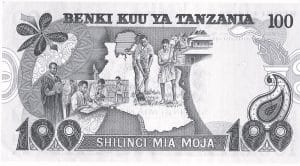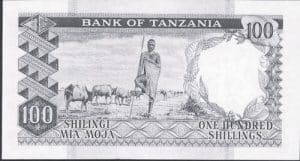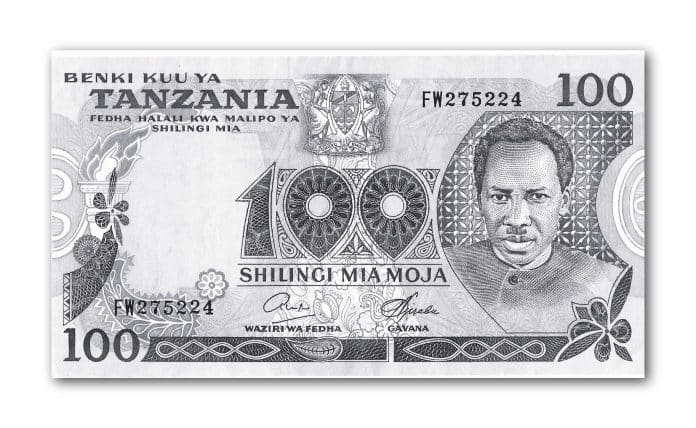The Tanzanian Shilling 100 Shilingi: Exploring the Cultural Significance and Economic Impact of Tanzania’s Iconic Banknote
Experience the rich cultural heritage and economic impact of Tanzania through the iconic Tanzanian Shilling 100 Shilingi banknote. This article delves into the historical and cultural significance of this beloved currency and explores its role in shaping the nation’s identity.
As you hold this banknote in your hands, you’ll be transported to the diverse landscapes and vibrant traditions that define Tanzania. From the awe-inspiring Mount Kilimanjaro to the bustling markets of Dar es Salaam, each element depicted on the note tells a story of the country’s past and present.
But beyond its cultural value, the Tanzanian Shilling 100 Shilingi banknote has a profound economic impact. Find out how this currency has influenced trade, tourism, and foreign investment in Tanzania. Discover why the stability and strength of the Tanzanian shilling are vital for the country’s financial growth.
Join us on a journey of discovery as we unravel the mysteries behind the Tanzanian Shilling 100 Shilingi banknote. Gain a deeper understanding of the culture and economy that make Tanzania a truly exceptional nation.
Historical background and design of the banknote

The Tanzanian Shilling 100 Shilingi banknote has a rich history that dates back to its introduction in 1986. Designed by renowned artist Abdulnassir Abdallah, this banknote reflects Tanzania’s cultural diversity and natural beauty. Its design showcases the country’s commitment to preserving its heritage and promoting national unity.
The front of the banknote features the portrait of the first President of Tanzania, Mwalimu Julius Kambarage Nyerere. A prominent figure in the country’s history, Nyerere played a crucial role in Tanzania’s independence and post-colonial development. His inclusion on the banknote symbolizes the nation’s gratitude and respect for his leadership.
The back of the banknote is adorned with various elements that represent Tanzania’s natural resources and cultural heritage. The majestic Mount Kilimanjaro takes center stage, towering over the Serengeti plains and the Great Rift Valley. This depiction showcases Tanzania’s stunning landscapes and highlights the importance of conservation efforts in preserving its unique ecosystems.
The banknote also features a traditional Tanzanian hut, known as a “banda,” which represents the rural communities that form the backbone of the country. This inclusion serves as a reminder of the importance of agriculture and rural development in Tanzania’s economy.
Overall, the design of the banknote reflects Tanzania’s commitment to honoring its past while embracing its future. It celebrates the nation’s cultural diversity and natural wonders, making it a true representation of the Tanzanian identity.
Cultural symbols and significance portrayed on the banknote

The Tanzanian Shilling 100 Shilingi banknote is more than just a form of currency. It serves as a canvas for showcasing the rich cultural heritage of Tanzania. Each element portrayed on the banknote carries deep meaning and significance, representing the country’s diverse communities and traditions.
One of the most prominent symbols on the banknote is the depiction of a Maasai warrior. The Maasai people are known for their distinctive dress and traditions, and their inclusion on the banknote highlights their cultural significance in Tanzanian society. The warrior’s presence serves as a reminder of the country’s ancestral roots and the importance of preserving indigenous cultures.
Another cultural symbol on the banknote is the depiction of a traditional Tanzanian drum. Drums hold great significance in Tanzanian culture, representing communal celebrations and gatherings. The inclusion of the drum on the banknote pays homage to the vibrant music and dance traditions that are an integral part of Tanzanian identity.
The banknote also features images of traditional Tanzanian fabric patterns, known as “kitenge.” These colorful and intricate designs are a cornerstone of Tanzanian fashion and serve as a symbol of national pride. By incorporating these patterns on the banknote, Tanzania celebrates its rich textile heritage and showcases its unique artistic expressions.
The cultural symbols portrayed on the Tanzanian Shilling 100 Shilingi banknote not only honor Tanzania’s traditions but also serve as a source of national pride. They remind Tanzanians and visitors alike of the country’s rich cultural tapestry and the importance of preserving and celebrating its diverse heritage.
Economic impact of the Tanzanian Shilling 100 Shilingi banknote
While the Tanzanian Shilling 100 Shilingi banknote holds immense cultural significance, it also plays a crucial role in Tanzania’s economy. As the primary currency of the country, the Tanzanian shilling facilitates trade, investment, and economic growth.
The stability and strength of the Tanzanian shilling have a direct impact on the country’s import and export industries. A strong currency allows Tanzania to negotiate favorable terms in international trade, ensuring that the value of its exports remains competitive. This, in turn, stimulates economic activity and drives growth in key sectors such as agriculture, mining, and manufacturing.
Furthermore, the Tanzanian Shilling 100 Shilingi banknote serves as a tool for promoting tourism. Tanzania is renowned for its breathtaking wildlife reserves, national parks, and historical sites. By featuring these attractions on the banknote, Tanzania entices tourists from around the world to visit and explore its natural wonders. The influx of tourism revenue contributes significantly to the country’s economy, providing employment opportunities and supporting local communities.
Foreign investment also relies on the stability of the Tanzanian shilling. A strong and reliable currency instills confidence in international investors, attracting capital inflows and stimulating economic development. The Tanzanian Shilling 100 Shilingi banknote serves as a symbol of Tanzania’s commitment to maintaining a stable and attractive investment climate.
In conclusion, the economic impact of the Tanzanian Shilling 100 Shilingi banknote cannot be overstated. It plays a vital role in facilitating trade, promoting tourism, and attracting foreign investment. The strength and stability of the Tanzanian shilling are crucial for Tanzania’s economic growth and development.
Collecting and preserving the Tanzanian Shilling 100 Shilingi banknote
The Tanzanian Shilling 100 Shilingi banknote holds tremendous cultural and historical value, making it a sought-after item for collectors worldwide. Collecting banknotes allows enthusiasts to delve into the rich heritage and stories behind each currency, providing a unique connection to the countries they represent.
When collecting the Tanzanian Shilling 100 Shilingi banknote, it is essential to consider its condition and rarity. Banknotes in excellent condition, without any damage or markings, are highly desirable among collectors. Additionally, banknotes with unique serial numbers or printing errors can fetch a higher value due to their rarity.
Proper preservation is crucial for maintaining the value and integrity of the banknote. It is recommended to store banknotes in acid-free and archival-quality holders or sleeves to prevent deterioration. Avoid exposure to direct sunlight, high humidity, or extreme temperatures, as these can damage the banknote over time.
For avid collectors, joining numismatic societies or online communities can provide a wealth of knowledge and resources. These platforms allow enthusiasts to connect with fellow collectors, learn about the history and significance of banknotes, and stay updated on the latest trends and discoveries in the field.
Collecting and preserving the Tanzanian Shilling 100 Shilingi banknote not only adds value to personal collections but also contributes to the preservation and appreciation of Tanzania’s cultural heritage. By cherishing these artifacts, collectors play a vital role in ensuring that the stories and symbols depicted on the banknote endure for future generations.
Counterfeiting and security features of the banknote
With the popularity and value of the Tanzanian Shilling 100 Shilingi banknote, it is essential to address the issue of counterfeiting. Counterfeit banknotes pose a significant threat to the integrity of the currency and can have severe economic consequences.
To combat counterfeiting, the Tanzanian Shilling 100 Shilingi banknote incorporates various security features. These features are designed to make it difficult for counterfeiters to replicate the banknote accurately. They also enable individuals and businesses to authenticate the banknote easily.
One of the most prominent security features is the use of advanced printing techniques, including intaglio printing. Intaglio printing creates raised ink on the banknote, giving it a tactile feel and making it difficult to reproduce accurately. Additionally, the use of specialized inks and watermarks further enhances the security of the banknote.
The banknote also incorporates security threads, which are embedded within the paper and contain unique patterns or microprinting. These threads are visible under ultraviolet light and serve as an additional layer of authentication. Additionally, the banknote may include holographic elements or color-shifting inks that change appearance when viewed from different angles.
Educating the public about the security features of the banknote is crucial in preventing counterfeiting. Banks, businesses, and individuals should be familiar with these features to detect counterfeit banknotes and report any suspicious activity to relevant authorities.
Overall, the inclusion of robust security features in the Tanzanian Shilling 100 Shilingi banknote ensures its integrity and helps safeguard Tanzania’s economy from the threats of counterfeiting.
Controversies and debates surrounding the banknote
Like any iconic symbol, the Tanzanian Shilling 100 Shilingi banknote has not been without controversy and debates. One of the primary controversies surrounding the banknote is the choice of portrait on the front. While many Tanzanians revere Mwalimu Julius Kambarage Nyerere, others argue that the banknote should feature a more diverse range of national heroes and figures.
Another point of contention involves the representation of certain cultural symbols on the banknote. Some argue that the Maasai warrior and other symbols perpetuate stereotypes and do not adequately represent the country’s diverse population. Critics suggest that a more inclusive approach should be taken to reflect the multicultural nature of Tanzania.
Debates also arise regarding the economic impact of the banknote. While the Tanzanian Shilling 100 Shilingi banknote plays a vital role in promoting tourism and foreign investment, some argue that it may contribute to income inequality. The concentration of wealth in urban areas, where tourism and investment are most prominent, may lead to disparities in economic development across the country.
It is essential to acknowledge and address these controversies and debates surrounding the banknote to foster a more inclusive and equitable society. By engaging in constructive discussions and promoting diverse representation, Tanzania can continue to evolve and shape its national identity in a way that reflects the aspirations and values of all its citizens.
The future of the Tanzanian Shilling 100 Shilingi banknote
As Tanzania continues to progress and embrace its future, the Tanzanian Shilling 100 Shilingi banknote will undoubtedly play a role in shaping the nation’s path forward. The banknote will continue to serve as a symbol of Tanzania’s cultural heritage and economic aspirations.
In the future, the design of the banknote may evolve to reflect a more inclusive and diverse representation of Tanzanian society. Efforts to feature a broader range of cultural symbols and national heroes may be undertaken to better showcase the country’s multicultural identity.
Technological advancements may also influence the future of the banknote. With the rise of digital currencies and cashless transactions, the use of physical banknotes may decrease over time. However, the Tanzanian Shilling 100 Shilingi banknote will likely remain an important cultural artifact and a symbol of national pride, even in a digital age.
Ultimately, the future of the Tanzanian Shilling 100 Shilingi banknote lies in the hands of the Tanzanian people. As they continue to shape their country’s identity and navigate the challenges and opportunities of the modern world, the banknote will serve as a reminder of their rich history and the potential for a bright future.
Similar banknotes from other countries and their cultural significance

The Tanzanian Shilling 100 Shilingi banknote is not the only currency that showcases cultural symbols and historical figures. Many other countries around the world incorporate similar elements on their banknotes, reflecting their unique heritage and national identity.
For example, the Indian Rupee features the image of Mahatma Gandhi, the iconic leader of India’s independence movement. Gandhi’s inclusion on the banknote represents his immense contribution to the country’s struggle for freedom and his enduring values of nonviolence and social justice.
In Australia, the Australian Dollar banknotes depict various notable figures from the country’s history. The $5 banknote features Queen Elizabeth II and Parliament House, symbolizing Australia’s ties to the British monarchy and its democratic institutions. The $100 banknote showcases the renowned soprano Dame Nellie Melba, honoring her contribution to the arts and cultural heritage of Australia.
Similarly, the United States Dollar incorporates images of past presidents, such as George Washington and Abraham Lincoln, on its banknotes. These figures represent the nation’s founding ideals and the enduring values of liberty, democracy, and equality.
These examples highlight how banknotes serve as a canvas for representing a country’s cultural heritage and historical figures. They provide a unique insight into the values and aspirations of a nation, allowing individuals to connect with their shared identity and history.
Conclusion: The enduring legacy of the Tanzanian Shilling 100 Shilingi banknote
The Tanzanian Shilling 100 Shilingi banknote encapsulates the spirit of Tanzania, representing its rich cultural heritage and economic aspirations. From its historical background and design to its cultural symbols and economic impact, this banknote tells a story of a nation that cherishes its past while embracing its future.
As collectors preserve and appreciate this iconic banknote, they contribute to the preservation of Tanzania’s cultural heritage. By understanding the security features and engaging in discussions surrounding the banknote, individuals can play an active role in safeguarding Tanzania’s economy and fostering inclusivity.
The future of the Tanzanian Shilling 100 Shilingi banknote lies in the hands of the Tanzanian people. As they continue to shape their country’s identity and navigate the challenges and opportunities of the modern world, this banknote will serve as a constant reminder of their rich history and the potential for a bright future.
For more articles related to Financial Services in Tanzania, click here!

































